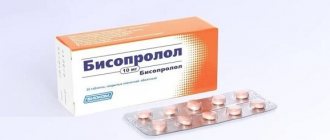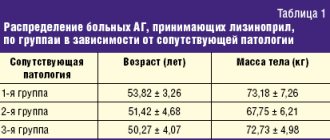High blood pressure is a common problem affecting both older and middle-aged people. Amlodipine is one of the popular drugs in the treatment of hypertension and angina. It is used by cardiologists and neurologists both in combination with other medications and as monotherapy.
Pharmacodynamics and pharmacokinetics
The active component is a dihydropyridine . The principle of action is aimed at blocking slow calcium channels. The drug has a hypotensive and antianginal effect. The main substance binds to dihydropyridine receptors, has a blocking effect on calcium channels, and slows down the transmembrane transition of calcium ions into the cell (there are slightly more vessels in the smooth muscle tissue than in carliomyocytes).
The antianginal effect of amlodipine is achieved by dilating arterioles, peripheral arteries, and coronary arteries, which in angina pectoris can reduce the severity of myocardial ischemia. Under the influence of the active component, the lumen of arterioles and coronary arteries in ischemic and unaffected areas of the myocardium expands, and the formation of constriction of the coronary arteries is prevented (during smoking).
The hypotensive effect of the drug is dose-dependent. A single dose of medication for arterial hypertension allows you to achieve a clinically significant drop in blood pressure within 24 hours. The drug does not affect the ejection fraction in the left ventricle, does not cause a decrease in exercise tolerance, and does not cause a sharp drop in blood pressure.
The medication has cardioprotective and antiatherosclerotic effects in ischemic heart disease. Amlodipine increases the glomerular filtration rate, inhibits platelet aggregation, does not cause a reflex increase in pulse, and has a weak natriuretic effect. The severity of microalbuminuria does not increase in patients with diabetic nephropathy . The drug does not affect plasma lipids or metabolic processes. The effect of taking a single dose of amlodipine is observed after 2 hours and lasts for a day.
Place of amlodipine in cardiological practice
Calcium antagonists (CAs) have been used in clinical practice for about four decades and are currently one of the most commonly prescribed drugs in cardiology. Such widespread use of AKs in clinical practice is associated with their high antihypertensive efficacy, metabolic neutrality and good tolerability [1, 14]. In recent years, calcium antagonists of the dihydropyridine, phenylalkylamine and benzothiazepine series have been present on the Russian pharmaceutical market, but dihydropyridine derivatives have found the most widespread use in clinical practice: nifedipine, amlodipine, isradipine, nitrendipine, lacidipine, felodipine, lercanidipine.
Today, the most prescribed representative of the calcium antagonists of the dihydropyridine series is amlodipine (Amlovas, Amlotop, Vero-Amlodipine, Kalchek, Cardilopin, Cordi Cor, Norvasc, Normodipin, Omelar Cardio, Stamlo, Tenox).
Amlodipine is a third-generation dihydropyridine calcium channel antagonist that blocks slow calcium channels (L-type channels) and prevents intracellular hypercalcemia and smooth muscle cell contraction, exerting a vasodilatory effect. It has a long-lasting effect, which allows it to be used once a day.
Pharmacokinetics
When taken orally, amlodipine is slowly and almost completely absorbed from the gastrointestinal tract, regardless of food intake. The bioavailability of amlodipine is high and ranges from 60 to 80%. The volume of distribution of the drug is on average 20–21 l/kg body weight, which is significantly more than that of other representatives of the dihydropyridine series. In serum, 95–98% of the drug dose is bound to plasma proteins. The maximum concentration in the blood is reached 6–12 hours after administration. The duration of action is due to its slow release from connection with receptors. Biotransformation to inactive metabolites occurs in the liver. The drug is excreted in the urine (about 10% unchanged and about 60% in the form of inactive metabolites) and in feces. The half-life is 35–50 hours. A stable equilibrium concentration (steady-state) is achieved after 7–8 days of taking the drug. With impaired liver function, the elimination time of amlodipine increases, which is also typical for other dihydropyridine calcium antagonists. Amlodipine does not cause impaired glucose tolerance and can be used in patients with diabetes mellitus.
Pharmacodynamics
Effect on blood pressure (BP) and heart rate (HR)
The effect of amlodipine (in the form of blocking slow calcium channels and reducing intracellular hypercalcemia) is 80 times more pronounced in relation to vascular smooth muscle cells compared to contractile myocardium. Thus, the decrease in blood pressure under the influence of amlodipine occurs precisely due to peripheral vasodilation. Amlodipine has a pronounced hypotensive effect on both systolic (SBP) and diastolic blood pressure (DBP).
Amlodipine has a long-term hypotensive effect due to its long half-life (35–50 hours), which allows it to control blood pressure evenly throughout the day, including preventing early morning rises in blood pressure, regardless of the time of taking the drug (morning or evening once a day) [8, 19]. In a study by Hayduk K. et al. during a break in treatment, blood pressure remained within normal values even on the second day of drug withdrawal [11]. The maximum hypotensive effect during therapy with 5 mg of amlodipine occurs only on the 6th week of drug use, which makes early dose increases inappropriate in case of incomplete control of blood pressure levels [30]. The drug has a dose-dependent effect on blood pressure levels and is characterized by a linear dose-concentration relationship in blood plasma. Thus, in a study on healthy volunteers, DBP decreased when measured while standing by 1.1; 4.8 and 8.0 mm Hg. Art., when using 2.5; 5 and 10 mg of amlodipine, respectively [17].
With the development of the hypotensive effect of amlodipine, there is no change in heart rate, which sets the drug apart from other representatives of the dihydropyridine series. In addition, the drug is well tolerated by patients. Side effects include swelling of the legs and hyperemia, which is characteristic of all AKs of the dihydropyridine series.
Effect on myocardial ischemia
The antianginal effect is determined by the peculiarity of the mechanism of action and is due to the coronary-lytic effect of the drug, which also determines the most preferable patient population. The effect of the drug is maximum in patients with severe vasospasm [21]. However, amlodipine is also widely used for the treatment of stable angina pectoris, significantly reducing the frequency, duration and severity of episodes of myocardial ischemia [16, 27]. One of the possible beneficial protective effects of amlodipine on the state of the myocardium after an episode of ischemia is considered to be its ability to reduce calcium overload of cells, which is the cause of myocardial damage [10]. An advantageous difference between amlodipine and earlier calcium antagonists is its lack of influence on heart rate, an increase in which during physical activity is one of the triggers for ischemia.
The CAPE study [3] studied the anti-ischemic properties of amlodipine in patients with coronary artery disease. During control 48-hour ECG monitoring, a decrease in the number of episodes of myocardial ischemia was observed. When amlodipine was added to traditional therapy with b-blockers and nitrates, no increase in episodes of arrhythmias was observed.
Effect on the sympathetic autonomic nervous system and plasma renin activity
Activation of the sympathetic component of the autonomic nervous system is an undesirable side effect of dihydropyridine calcium antagonists due to their direct mechanism of action. However, a peculiarity of the action of amlodipine is the lack of activation of the sympathetic nervous system and the development of reflex tachycardia. Thus, when determining norepinephrine in the blood of patients taking amlodipine, there was no increase in its level compared to the baseline [23]. During spectral analysis, no increase in LF/HF was observed [24]. The lack of effect of amlodipine on plasma renin activity and norepinephrine levels in patients with arterial hypertension (AH) was shown in a study by Susaguri et al. [24].
Effect on left ventricular myocardial mass
The cardioprotective effect and ability of amlodipine to reduce left ventricular myocardial mass were demonstrated in the randomized, double-blind, placebo-controlled TOMHS study, which compared 5 antihypertensive drugs: a diuretic (chlorthalidone), a β-blocker (acebutolol), a calcium channel antagonist (amlodipine), ACE inhibitor (enalapril), α-adrenergic receptor antagonist (doxazosin). When studying the dynamics of changes in left ventricular myocardial mass, it turned out that the most pronounced decrease was observed in the amlodipine and chlorthalidone groups, compared with the acebutolol and placebo groups, and led to a decrease in the risk of developing cardiovascular complications in hypertensive patients with left ventricular hypertrophy.
Effect on the progression of vascular atherosclerosis
The beneficial effect of AA on the state of the vascular endothelium was confirmed in the multicenter, prospective, randomized, double-blind, placebo-controlled PREVENT study [22], which assessed changes in the degree of atherosclerotic lesions of the coronary arteries and the thickness of the intimomedial layer of the carotid arteries during the administration of amlodipine. There was a pronounced effect of amlodipine on the progression of atherosclerosis in the carotid arteries, detected using ultrasonography. At the same time, in the amlodipine group, regression of the intimomedial layer was observed by 0.046 mm, and in the control group, a thickening of 0.011 mm was observed. Currently, a correlation has been proven between the degree of thickening of the intimomedial layer of the carotid arteries and the incidence of myocardial infarction (MI) and cerebral stroke.
Clinical experience
Arterial hypertension
Antihypertensive effect
Amlodipine effectively reduces SBP and DBP levels both in monotherapy and as part of combination therapy. Amlodipine is a competitive drug when compared with other calcium antagonists and drugs from other classes of antihypertensive drugs [9].
When comparing the effect of amlodipine with the effect of other calcium antagonists, its greater effectiveness in relation to blood pressure levels is shown in comparison with verapamil and diltiazem. Thus, in a study by Watts RW et al. [29] compared amlodipine (5–10 mg) and controlled-release diltiazem (180–360 mg), and mean daily blood pressure decreased with amlodipine to 137/84 mmHg. Art., and when using diltiazem - up to 143/86 mm Hg. Art. In numerous comparisons of amlodipine with other dihydropyridine calcium antagonists, it had a comparable but significantly longer antihypertensive effect [8, 13]. At the same time, the advantageous advantage of the drug over other dihydropyridine calcium antagonists is the lack of its effect on heart rate, which allows it to be prescribed to patients with tachysystole.
In terms of reducing the risk of developing cardiovascular complications and improving the prognosis for hypertension (the main goal in the treatment of this disease), amlodipine, according to studies such as ALLHAT [25] and VALUE [12], was comparable in effectiveness to ACE inhibitors and angiotensin receptor blockers, and in some respects even better. Compared with valsartan, an antihypertensive therapy regimen based on amlodipine significantly reduced the incidence of MI by 19% in hypertensive patients with numerous concomitant risk factors.
Organoprotective effects
The angioprotective effects of amlodipine were demonstrated in the PREVENT study [22]. It was shown that in patients with coronary heart disease (CHD), amlodipine contributed to a decrease in the intima-media thickness index compared to a group of patients with CHD who received placebo. Perhaps it is the slowdown in the progression of carotid artery atherosclerosis that explains the data obtained in many studies indicating a particularly pronounced reduction in the incidence of cerebrovascular accidents during treatment with calcium antagonists [28]. The results of the CAMELOT study [18] allow us to judge the antiatherosclerotic effect of amlodipine in relation to the coronary arteries.
The most important element of organ protection in the treatment of patients with hypertension is the prevention of stroke. The ASCOT study compared the effectiveness of antihypertensive therapy based on the use of the calcium antagonist amlodipine followed by the addition of the ACE inhibitor perindopril with therapy based on the use of the beta-blocker atenolol and the thiazide diuretic bendroflumethiazide. Both groups showed a comparable reduction in blood pressure, but in the amlodipine and ACE inhibitor group the relative risk of stroke was 23% lower than in the atenolol and diuretic group (p = 0.0003) [4]. The results of the ASCOT study suggest that, in addition to their hypotensive effects, calcium antagonists and ACE inhibitors have additional properties that may reduce the risk of cerebrovascular complications.
The most important characteristic of an antihypertensive drug is its metabolic effects, in particular, the effect on carbohydrate metabolism [26]. Since the development of diabetes in hypertensive patients significantly increases the risk of cardiovascular complications [7], the selection of antihypertensive therapy must be carried out taking into account its effect on the risk of diabetes. Calcium antagonists reduce the incidence of new cases of diabetes compared to diuretic therapy [12, 25]. In the ALLHAT study, depending on the frequency of new cases of diabetes in the comparison groups, the tested drugs were distributed as follows: chlorthalidone > amlodipine > lisinopril [25]. However, the beneficial effect of amlodipine was especially evident in the ASCOT study [4], where, during treatment with amlodipine in combination with perindopril, the likelihood of developing new cases of diabetes was 30% less than in the group of patients receiving therapy with atenolol and the thiazide diuretic bendroflumethiazide.
The results of major studies (PREVENT, INSIGHT, ELSA, CAMELOT, etc.) served as a prerequisite for expanding the indications for the use of AC in patients with hypertension and introducing into the new recommendations the presence of atherosclerosis of the carotid and coronary arteries in patients with hypertension as one of the indications for the primary use of AC dihydropyridine group [26]. In addition, in the 2007 European recommendations, calcium antagonists from the group of dihydropyridine derivatives (amlodipine) are indicated as the drugs of choice in elderly patients with isolated systolic hypertension, angina pectoris, left ventricular myocardial hypertrophy, peripheral vascular diseases, pregnancy, atherosclerosis of the carotid and coronary arteries.
Cardiac ischemia. Angina pectoris
Amlodipine has a pronounced coronary effect due to its high selectivity for smooth muscle cells of arterioles. The steal syndrome that occurs when using short-acting AKs is much less pronounced in long-acting drugs, in particular amlodipine. Amlodipine is widely used for the treatment of stable angina pectoris, both in monotherapy and (more often) and as part of combination therapy. Amlodipine also has a beneficial effect when used in patients with a pronounced dynamic component of coronary obstruction [3].
The anti-ischemic effects of amlodipine, its ability to reduce the frequency of episodes of ST segment depression, the total ischemic time (as measured by ECG), as well as the frequency of painful ischemic episodes and the frequency of additional use of short-acting nitrates, have been demonstrated in a number of studies, including the multicenter CAPE study [5, 6].
The effect of amlodipine on the prognosis of patients with coronary artery disease was assessed in the PREVENT study [22]. There was a decrease in the number of hospitalizations caused by destabilization of the course of angina pectoris and chronic heart failure (CHF); reduction in the number of myocardial revascularization operations (53 compared with 85 in the placebo group), regardless of the use of beta-blockers, nitrates or lipid-lowering therapy.
In a meta-analysis, Kloner RA et al. [15] assessed the safety of calcium channel antagonists. Comparative and non-comparative studies of amlodipine and nifedipine GITS were included. It was shown that in patients receiving amlodipine, overall cardiovascular mortality, the incidence of acute myocardial infarction and progression of coronary artery disease were significantly lower than similar indicators for other calcium antagonists.
According to the CAMELOT study, amlodipine compared with placebo by 31% (p < 0.003) reduced the incidence of adverse cardiovascular events (cardiovascular death, non-fatal myocardial infarction, coronary revascularization, the need for hospitalization due to angina, heart failure, fatal or non-fatal stroke or peripheral arterial disease) mainly due to a decrease in the rate of revascularization [18].
Chronic heart failure
The randomized, double-blind, placebo-controlled study PRAISE I [20] studied the effects of amlodipine in patients with CHF. The study included 1153 patients with an ejection fraction of less than 30% and CHF of ischemic and non-ischemic origin. Amlodipine vs placebo led to a 9% reduction in the total number of cardiovascular complications and a 16% reduction in the risk of sudden death. Moreover, the change concerned exclusively patients with non-ischemic heart failure, who experienced a 31% reduction in the total number of cardiovascular complications and a 46% reduction in the risk of sudden death when using amlodipine. The PRAISE II study showed a reduction in clinical symptoms and plasma norepinephrine levels with amlodipine in patients with dilated cardiomyopathy. A number of authors associate this effect of amlodipine with inhibition of NO hyperproduction and a decrease in myocardial damage.
Conclusion
The antagonist of slow L-type calcium channels from the group of dihydropyridines, amlodipine, is effective in mono- and combination therapy in patients with hypertension, coronary artery disease with severe coronary spasm, both in monotherapy and in combination with other antianginal and antihypertensive drugs [2]. The effect of amlodipine on cardiovascular risk is confirmed by the results of a large number of large international multicenter randomized, placebo-controlled clinical trials (
.).
Amlodipine is a long-acting drug, which neutralizes the sharp hemodynamic changes characteristic of the initial period of absorption of short-acting AA.
An important feature of the action of amlodipine is the lack of influence on heart rate, which expands the possibilities of using the drug.
Amlodipine has a good range of safety and tolerability; the percentage of adverse reactions when using it does not significantly exceed the placebo effect.
For questions regarding literature, please contact the editor.
T. E. Morozova , Doctor of Medical Sciences, Professor V. L. Zakharova , Candidate of Medical Sciences MMA named after. I. M. Sechenova , Moscow
Contraindications
Contraindications to the use of the drug are: intolerance to dihydropyridines , pregnancy , severe arterial hypotension , breastfeeding . For aortic stenosis , arterial hypotension , acute myocardial infarction , renal pathology, children under adulthood, CHF, mitral stenosis , elderly patients with CVS, HOCM - Amlodipine is prescribed with caution.
Side effects of Amlodipine
Digestive tract: dry mouth, yellowness of the skin, nausea, increased levels of liver enzymes, vomiting, dyspeptic disorders, pancreatitis , flatulence , diarrhea , constipation , gum hyperplasia, pain in the epigastric region, appetite disturbances.
Nervous system: convulsions, mood changes, drowsiness, headache, depression, nervousness, insomnia, malaise, fatigue, asthenia, tremor, paresthesia, hyperesthesia, amnesia , agitation , apathy , ataxia .
Cardiovascular system: ventricular tachycardia , swelling, blood flow disorders to the face, palpitations, chest pain, drop in blood pressure, migraine, extrasystole, atrial flutter, worsening heart failure, orthostatic hypotension, rise in blood pressure.
Genitourinary system: polyuria , pollakiuria , nocturia , pain during urination, sexual dysfunction, potency disorders, dysuria .
Musculoskeletal system: myasthenia gravis , arthrosis , arthralgia , myalgia .
Skin: alopecia , xeroderma , purpura , dermatitis. It is also possible to develop conjunctivitis , rash, itching, diplopia, visual disturbances, gynecomastia , ringing in the ears, chills, xerophthalmia , accommodation disturbances , parosmia , rhinitis , cough, clammy sweat, nosebleeds, hyperglycemia , thirst , increased sweating, perversion of taste perception.
Reviews of side effects of Amlodipine are quite common.
Amlodipine drug overdose, symptoms and treatment
Significant overdose can lead to excessive peripheral vasodilation and a subsequent noticeable and possibly lasting decrease in blood pressure. If clinically significant arterial hypotension occurs due to an overdose of amlodipine, it is necessary to take active measures aimed at maintaining the function of the cardiovascular system, including monitoring heart and lung parameters, positioning the patient lying down with the lower extremities elevated, and monitoring blood volume and diuresis. To restore vascular tone and normal blood pressure levels, the use of vasopressor drugs is indicated. To eliminate the effects of calcium channel blockade, calcium gluconate is administered intravenously. Since amlodipine is highly bound to plasma proteins, dialysis is ineffective.
List of pharmacies where you can buy Amlodipine:
- Moscow
- Saint Petersburg
Amlodipine tablets, instructions for use (Method and dosage)
The drug is taken orally, the initial dosage is 5 mg. The amount of medication is gradually increased over two weeks to a maximum of 10 mg per day once.
The maintenance daily dosage for arterial hypertension is 2.5-5 mg.
For vasospastic angina, exertional angina, a single dose of 5-10 mg per day is prescribed. To prevent angina attacks, a daily dose of 10 mg is indicated.
Patients with kidney pathology, low body weight, and short stature are prescribed 2.5 mg per day, to achieve an antianginal effect - 5 mg.
The initial dosage for CHF is 2.5 mg per day, the dosage is gradually increased to 10 mg per day if the medication is well tolerated.
Instructions for use of Amlodipine Teva, Amlodipine Farmak and Biocom are similar.
conclusions
A single use of Amlodipine by patients with arterial hypertension provides a stable reduction in blood pressure for 24 hours. Due to the smooth increase in the pharmacological effect, there are no symptoms of acute hypotension.
Pleiotropic (multidirectional) action "Amlodipine" controls the course of diseases that often accompany hypertension - diabetes mellitus, metabolic syndrome, atherosclerosis, obstructive pulmonary pathology and gout.
Before using Amlodipine, you should consult your doctor and carefully study the instructions.
Interaction
Indomethacin (blockade of prostaglandin synthesis by the renal system, sodium ion retention), sympathomimetics, estrogens, alpha-adrenergic stimulants, NSAIDs - weaken the severity of the hypotensive effect.
Inhibitors of microsomal oxidation increase the risk of side effects due to an increase in the concentration of the drug in the blood; the opposite effect is observed when taking inducers of microsomal enzymes.
Nitrates, loop diuretics, Verapamil , beta-blockers, thiazide diuretics, ACE inhibitors increase the severity of the hypotensive and antianginal effects.
Antipsychotics, alpha1-blockers, quinidine, amiodarone, BMCC enhance the hypotensive effect of amlodipine.
Warfarin , Cimetidine and Digoxin do not affect pharmacokinetic parameters.
When taking lithium preparations, an increase in neurotoxicity is recorded (tinnitus, ataxia, diarrhea, nausea, tremor, vomiting).
Calcium supplements reduce the effectiveness of BMCC. Quinidine , procainamide enhance the negative inotropic effect.
Description of the drug
The main purpose of Amlodipine is to lower blood pressure and reduce the risk of angina attacks.
The main active ingredient is amlodipine besylate. Auxiliary components are presented: crospovidone, calcium stearate, povidone, lactose monohydrate, microcrystalline cellulose.
Available in the form of white or slightly yellowish tablets with a score. Depending on the concentration of the main active ingredient, Amlodipine is available in pharmacies 5 mg or 10 mg. Packaged in 30, 50 or 90 pieces in cardboard boxes along with instructions. Produced in Russia and Serbia. The drug is stored for 3 years at a temperature not exceeding 25°C.
Has the following positive effects:
- Helps normalize blood pressure.
- Improves the functioning of the cardiovascular system by increasing the supply of oxygen to the heart muscle.
- Reduces blood viscosity.
- Improves cerebral circulation.
Advantages of the drug:
- Does not affect the number of heart contractions.
- Does not cause a rapid decrease in pressure, has a long-term effect due to its effect on vascular tissue.
- Increases resistance to physical activity in people with heart disease.
special instructions
There is no reliable information about the safety of amlodipine for lactating and pregnant women. Therapy requires observation by a dentist for the prevention and timely diagnosis of gum hyperplasia , bleeding and pain.
The drug has no effect on plasma concentrations of cholesterol , triglycerides, glucose, uric acid, urea, nitrogen, LDL. The drug is not characterized by a withdrawal syndrome, however, patients are advised to gradually reduce the dosage of the drug before discontinuing it.
The drug is often used in combination with various active substances: valsartan, perindopril, lisinopril, bisoprolol.
Amlodipine analogs
Level 4 ATC code matches:
Lacipil
Cordafen
Azomex
Nimodipine
Felodipin
Nifedipine
Farmadipin
Amlotop
Nimotop
Tenox
Nifecard HL
Cordipin
Felodip
Normodipine
Phenigidine
Norvask
Cordaflex
Lerkamen
Corinfar
Vero-Amlodipine
What can replace the medicine? Analogues of the drug are the following medications:
- Norvask
- Amlotop
- Kalchek
- Tenox
- Amlovas
- Cardilopin
- Amlong
- Amlodak
- Amlocard
- Amlonorm
- Amlodivel
Amlodipine price, where to buy
The price of Amlodipine greatly depends on the manufacturer and has a wide range.
Buy Amlodipine-Teva 5 mg 30 pcs. you can do it for about 120 rubles.
- Online pharmacies in RussiaRussia
- Online pharmacies in UkraineUkraine
- Online pharmacies in KazakhstanKazakhstan
ZdravCity
- Amlodipine-KRKA tablets 5 mg 30 pcs Krka-Rus LLC
160 rub. order - Amlodipine-KRKA tablets 10 mg 30 pcs Krka-Rus LLC
RUB 243 order
- Amlodipine-Borimed tab. 5mg No. 30 Borisov Medical Preparations Plant OJSC
33 rub. order
- Amlodipine-Borimed tab 10mg No. 30 Borisov Medical Preparations Plant OJSC
38 rub. order
- Amlodipine-Teva tablets 5 mg 30 pcs. Teva LLC
122 RUR order
Pharmacy Dialogue
- Amlodipine-Teva tablets 5 mg No. 30Teva
114 RUR order
- Amlodipine tablets 5 mg No. 30Canonpharma Production
94 RUR order
- Amlodipine (5 mg tablet No. 90 (can)) Canonpharma Production CJSC
RUB 176 order
- Amlodipine tablets 10 mg No. 60Kanonpharma Production
RUB 156 order
- Amlodipine tablets 5 mg No. 90Kanonpharma Production
RUB 176 order
show more
Pharmacy24
- Amlodipine-Darnitsa 10 mg N20 tablets PrAT" Pharmaceutical company "Darnitsa", Ukraine
11 UAH. order - Amlodipine Astrapharm 10 mg N20 tablets TOV Astrapharm, Ukraine
11 UAH order
- Amlodipine-Darnitsa 5 mg N20 tablets PrAT” Pharmaceutical company “Darnitsa”, Ukraine
6 UAH order
- Amlodipine Fitofarm 5 mg N20 tablets PRAT "Fitofarm", Ukraine
5 UAH order
- Amlodipine Farmak 0.005 N20 tablets PAT "Farmak", Ukraine
12 UAH order
PaniPharmacy
- tablets Amlodipine Sandoz tablets 5 mg No. 30 Ukraine, Lek
35 UAH order
- Amlodipine tablets Amlodipine tablets 0.05g No. 20 Ukraine, Farmak OJSC
12 UAH order
- Amlodipine tablets Amlodipine tablets 5 mg No. 20 Ukraine, Fitofarm ChAO
6 UAH order
- Amlodipine tablets Amlodipine tablets 5 mg No. 30 Ukraine, Kiev Vitamin Plant PJSC
13 UAH order
- Amlodipine tablets Amlodipine tablets 10 mg No. 30 Ukraine, Astrapharm LLC
19 UAH order
show more






